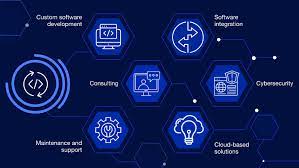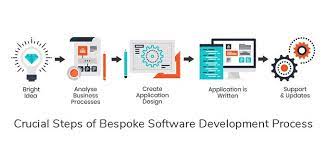Understanding Scrum Development
Scrum is a popular agile framework used in software development to manage complex projects. It emphasizes collaboration, flexibility, and continuous improvement to deliver high-quality products efficiently. Here are some key aspects of Scrum development:
Roles in Scrum:
- Product Owner: Represents the stakeholders and ensures that the team delivers value to the customer.
- Scrum Master: Facilitates the Scrum process and helps the team overcome any obstacles.
- Development Team: Self-organizing team responsible for delivering increments of work during each sprint.
Artifacts in Scrum:
- Product Backlog: A prioritized list of features, enhancements, and bug fixes maintained by the Product Owner.
- Sprint Backlog: A list of tasks selected by the team to complete during a sprint.
- Increment: The sum of all completed product backlog items at the end of a sprint.
Events in Scrum:
- Sprint Planning: Meeting where the team plans the work for the upcoming sprint.
- Daily Standup: Daily meeting for team members to synchronize their work and identify any impediments.
- Sprint Review: Meeting where the team demonstrates completed work to stakeholders and gathers feedback.
- Sprint Retrospective: Meeting where the team reflects on their process and identifies opportunities for improvement.
In conclusion, Scrum development is an effective framework for managing complex projects by promoting transparency, inspection, and adaptation. By following its principles and practices, teams can deliver valuable products iteratively while fostering collaboration and continuous improvement.
9 Essential Tips for Effective Scrum Development
- Ensure the Scrum team is cross-functional and self-organizing.
- Hold regular sprint planning meetings to prioritize work and set goals.
- Use a burndown chart to track progress throughout the sprint.
- Encourage open communication and collaboration within the team.
- Conduct daily stand-up meetings to discuss progress, challenges, and plans for the day.
- Review and adapt processes during sprint retrospective meetings for continuous improvement.
- Break down tasks into small, manageable units to increase efficiency and focus.
- Prioritize delivering working software in each sprint to provide value early and often.
- Empower the Product Owner to make decisions on behalf of stakeholders.
Ensure the Scrum team is cross-functional and self-organizing.
To ensure the success of a Scrum development project, it is crucial to have a cross-functional and self-organizing team. A cross-functional team consists of members with diverse skills and expertise, allowing them to tackle various aspects of the project without relying on external resources. This promotes efficiency and autonomy within the team, enabling them to make decisions collectively and adapt to changing requirements quickly. By fostering a self-organizing environment, the Scrum team can maximize productivity, creativity, and collaboration, ultimately leading to successful project outcomes.
Hold regular sprint planning meetings to prioritize work and set goals.
To maximize the efficiency and effectiveness of your Scrum development process, it is crucial to hold regular sprint planning meetings. These meetings play a vital role in prioritizing work, setting clear goals for the upcoming sprint, and ensuring that the team is aligned on the tasks at hand. By establishing a structured approach to planning and goal-setting, teams can streamline their workflow, improve communication, and increase the likelihood of delivering high-quality products within the designated timeframe. Regular sprint planning meetings help teams stay focused, organized, and proactive in their approach to project management within the Scrum framework.
Use a burndown chart to track progress throughout the sprint.
Using a burndown chart is a valuable tip in Scrum development as it provides a visual representation of the team’s progress throughout the sprint. This chart tracks the remaining work against the time available, allowing the team to see if they are on track to complete all planned tasks by the end of the sprint. By regularly updating and reviewing the burndown chart, team members can identify any potential issues early on and make necessary adjustments to ensure successful completion of the sprint goals.
Encourage open communication and collaboration within the team.
Encouraging open communication and collaboration within the team is essential in Scrum development. By fostering an environment where team members feel comfortable sharing ideas, concerns, and feedback, the team can work more effectively towards achieving its goals. Open communication helps in identifying potential issues early on, promoting transparency, and ensuring that everyone is aligned on project objectives. Collaboration allows team members to leverage each other’s strengths, brainstorm solutions collectively, and ultimately deliver high-quality products efficiently. Emphasizing open communication and collaboration not only enhances teamwork but also contributes to a positive and productive work environment in Scrum development.
Conduct daily stand-up meetings to discuss progress, challenges, and plans for the day.
In Scrum development, conducting daily stand-up meetings is a crucial practice to ensure team alignment and progress tracking. These brief meetings provide a platform for team members to discuss their achievements, challenges faced, and plans for the day ahead. By fostering open communication and collaboration, daily stand-ups help identify any potential roadblocks early on and allow the team to adapt their approach accordingly. This regular check-in not only promotes accountability but also enhances team cohesion and ensures that everyone is on the same page towards achieving project goals.
Review and adapt processes during sprint retrospective meetings for continuous improvement.
During sprint retrospective meetings in Scrum development, it is crucial to review and adapt processes to foster continuous improvement. This practice allows teams to reflect on their performance during the sprint, identify what worked well and what didn’t, and make necessary adjustments for future sprints. By actively seeking feedback and addressing any issues or inefficiencies, teams can enhance their productivity, collaboration, and overall effectiveness in delivering high-quality products. Embracing this iterative approach to process improvement not only helps teams achieve better results but also promotes a culture of learning and growth within the organization.
Break down tasks into small, manageable units to increase efficiency and focus.
Breaking down tasks into small, manageable units is a crucial tip in Scrum development that can significantly enhance efficiency and focus. By dividing work into smaller chunks, teams can better prioritize, track progress, and adapt to changes more effectively. This approach also helps team members maintain a clear understanding of their responsibilities, leading to improved collaboration and productivity. Ultimately, breaking tasks into manageable units not only streamlines the development process but also ensures that the team stays on track towards achieving their goals in a structured and organized manner.
Prioritize delivering working software in each sprint to provide value early and often.
In Scrum development, it is crucial to prioritize delivering working software in each sprint to provide value early and often. By focusing on delivering functional and usable features at the end of every sprint, teams can ensure that stakeholders receive tangible results and feedback quickly. This approach not only demonstrates progress but also allows for adjustments based on real-world usage, leading to a more efficient and effective development process. Prioritizing working software delivery helps teams stay aligned with customer needs and continuously deliver value throughout the project lifecycle.
Empower the Product Owner to make decisions on behalf of stakeholders.
In Scrum development, it is crucial to empower the Product Owner to make decisions on behalf of stakeholders. By giving the Product Owner the authority to prioritize the product backlog and make key decisions, the development team can focus on delivering value without being bogged down by constant changes or conflicting requests. This empowerment streamlines the decision-making process, ensures clear direction for the team, and ultimately leads to more efficient and successful project outcomes.




